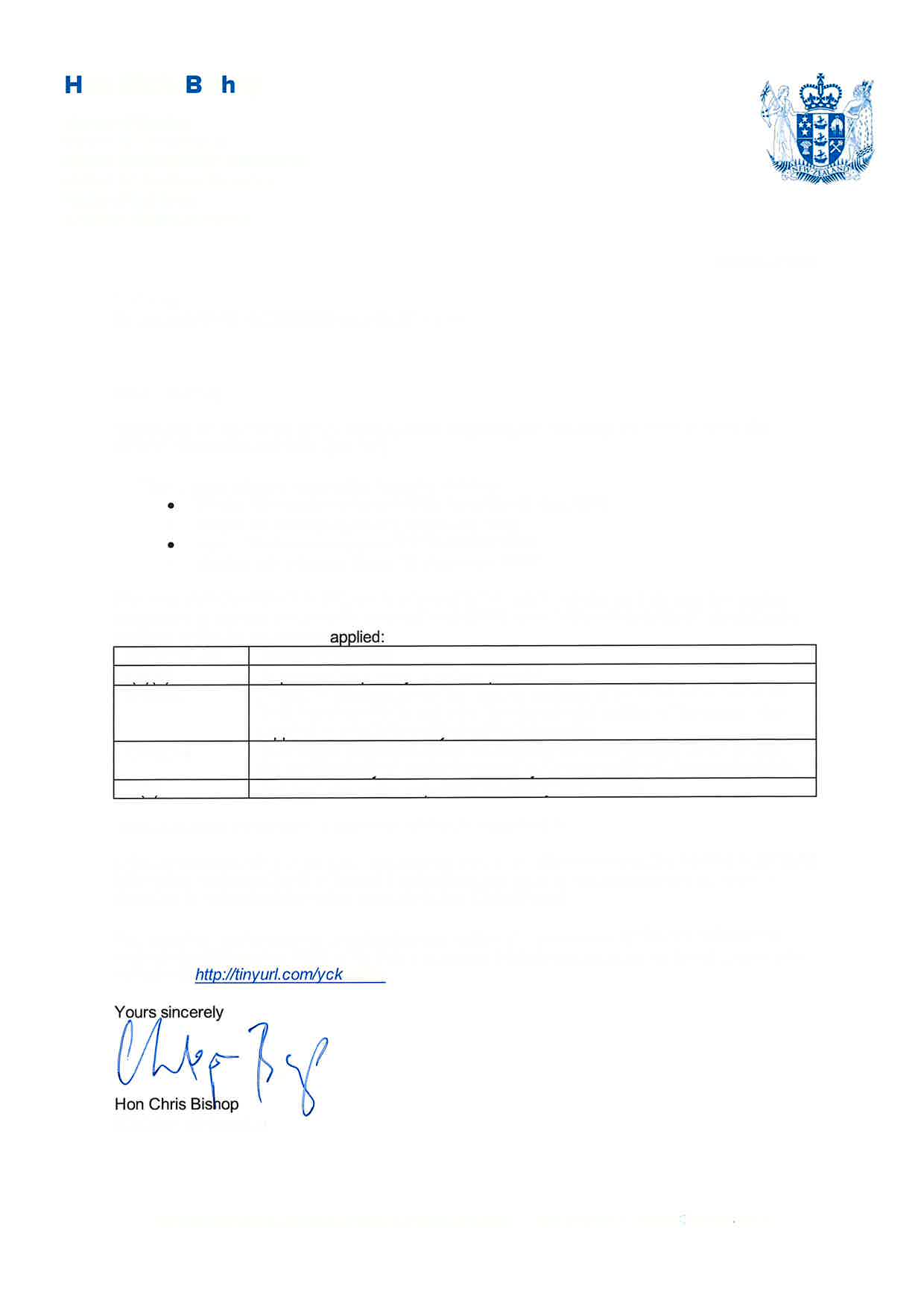

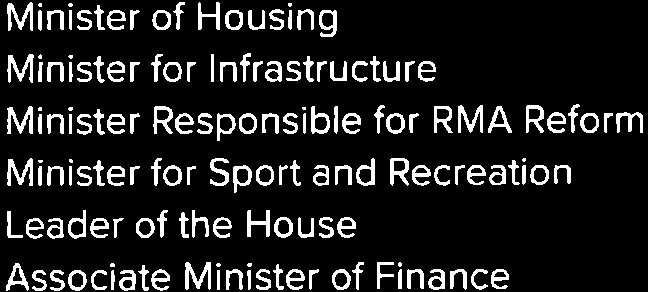
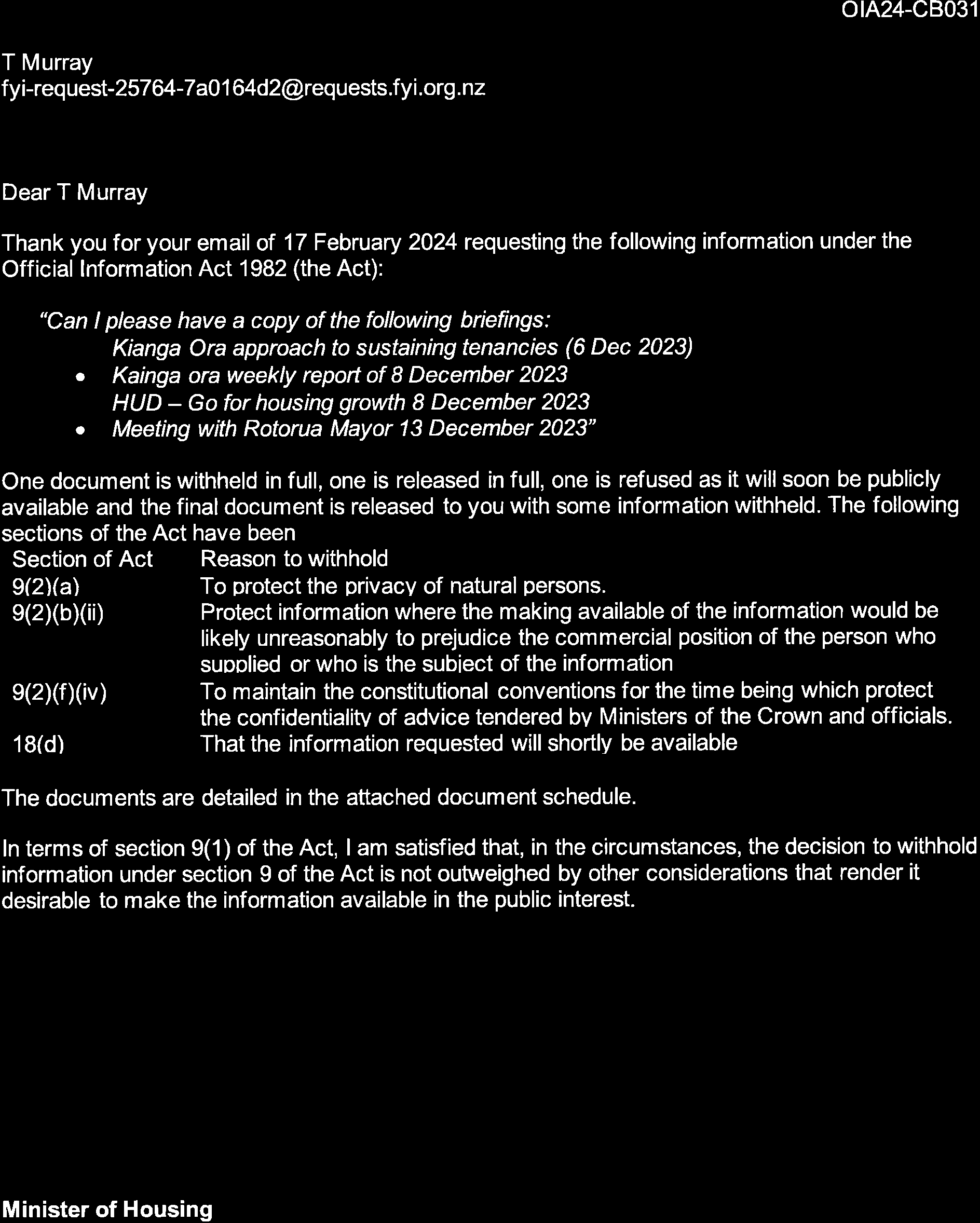







AH 23 093
6 December 2023
Minister of Housing
Cc Board Chair, Vui Mark Gosche
Kāinga Ora Approach to Sustaining Tenancies
Purpose
1. This briefing responds to your request for information on the Kāinga Ora sustaining tenancies
policy specifically around disruptive behaviour. While this briefing provides a high-level overview
of this approach, a more detailed overview briefing of how Kāinga Ora approaches and
responds to disruptive behaviour is available at your request.
2. The Kāinga Ora approach to sustaining tenancies was based on the concepts in a 2016 Cabinet
paper1, recognising that there is a broader social cost incurred when a tenancy is ended and the
household has nowhere else to live. In addition to the immediate increase in cost to government
when a tenant moves from an Income Related Rent Subsidy (IRRS) and into Emergency
Housing, research shows that a lack of housing stability also has flow-on effects on both time
and cost pressures on the health system, education and employment outcomes, policing and
the justice sector.
Background
3. The 2017/18 Letter of Expectations also noted the redesign of the tenancy management
activities in line with this approach and encouraged Housing New Zealand Corporation to
continue this workstream and report back on development.
4. In 2019, the sustaining tenancies approach was specifically included in the Kāinga Ora – Homes
and Communities Act 2019 (the Act) as an operating principle to support tenants to sustain their
tenancies, and in successive letters of expectation.
Legal framework
5. In summary, the Kāinga Ora - Homes and Communities Act 2019 sets out the objectives,
functions and operating principles of Kāinga Ora. The organisation is required to act in a manner
consistent with these operating principles and the Board must ensure Kāinga Ora acts in a
manner consistent with the operating principles in the Kāinga Ora Act (s11(1)(a)).
6. The Residential Tenancies Act 1986 (RTA) sets out the obligations for both tenants and
landlords, including in relation to disruptive behaviour. The RTA provides the legal framework
for managing disruptive behaviour and gives Kāinga Ora, and other landlords, the legal tools
and the institutional mechanisms for making decisions on tenancies. The RTA also has special
provisions relating to terminating social housing tenancies (section 53B), which can be used for
two very specific reasons:
a. Kāinga Ora has been notified by MSD that the tenant is no longer eligible for social
housing.
1 CAB-16-MIN-0341 refers
b. Kāinga Ora requires the tenants to transfer to different Kāinga Ora housing, the transfer
is necessary/desirable, and the housing is appropriate for the tenant's housing needs as
most recently assessed.
7. There are evidential thresholds for these provisions and a process that must be followed to
ensure that the legislative criteria are met. The ultimate decision maker is the Tenancy Tribunal
adjudicator who decides whether the evidence is sufficient and whether a tenancy can be
ended.
Policy
8. Kāinga Ora has a suite of operational policies in place to implement this approach and respond
to the current operating context, within the bounds of the legal framework.
9. In 2022, Kāinga Ora introduced a new operating model to better support tenants to manage their
tenancies successfully and live well in their home. The new operating model introduced a
clearer and more robust referral system to support the integration of health and social services
to assist the household to successfully manage the tenancy, where needed. The success of
these referrals is dependent on the capacity and availability of other agencies and service
providers to effectively support Kāinga Ora tenants with their specific needs.
10. Over time, this new operating model is expected to result in a reduction in disruptive behaviour,
an increase in successful tenancies, and improved outcomes for tenants with reduced long-term
costs to government.
11. To help manage complex tenancy issues, Kāinga Ora has established an internal Review
Group. The group also helps ensure there is a consistent national approach and that issues can
be addressed in timely manner.
12. Under the current legislative functions, Kāinga Ora is restricted to providing appropriate housing
to tenants and does not extend to the provision of social/wellbeing services. If it was intended
that Kāinga Ora should provide targeted support directly to tenants, legislative change may be
required.
Options to strengthen our approach
13. The tools available to Kāinga Ora, including through the RTA are outlined below. The threshold
at which these are used is determined by Kāinga Ora.
a. Agreed relocation – where a tenant is wil ing to work with Kāinga Ora to move to a new
home, this can be done without the need for any RTA tools to be used.
b. s53b Notices (required relocation - Kāinga Ora can use Section 53B of the RTA to end a
tenancy and transfer the tenant to another Kainga Ora home. Kainga Ora must provide at
least 90 days’ notice to the tenant.
c. s55a notices – where behaviour meets the definition in the RTA, a notice can be issued to
address the behaviour and provide an opportunity for change. If there is another specific and
separate incidence, Kainga Ora can issue another notice. When three notices are issued
within a 90-day period, Kāinga Ora can apply to the Tenancy Tribunal to end the tenancy.
d. s55 tenancy termination - where disruptive behaviour places neighbours, the community or
Kāinga Ora staff at significant risk, an application can be made to the Tenancy Tribunal to
seek termination of the tenancy.
14. Later this month the Kāinga Ora Board wil be discussing options to strengthen our approach to
disruptive behaviour. In particular, this will look at how we categorise behaviour and the use of
tools we use to respond to it.
2
 Options for changes to the sustaining tenancies approach
Options for changes to the sustaining tenancies approach
15. If it was agreed that changes are required, a Minister can influence operational policy settings of
a Crown agent through use of formal tools under the Crown Entities Act 2004. This includes a
formal direction (but not in relation to individuals) or accountability documents such as the SPE,
and by setting clear expectations for the Board though a Letter of Expectations. Kāinga Ora
would still be required to adhere to all relevant legislation, unless legislative changes were also
made.
Nick Maling
General Manager, National Services
3
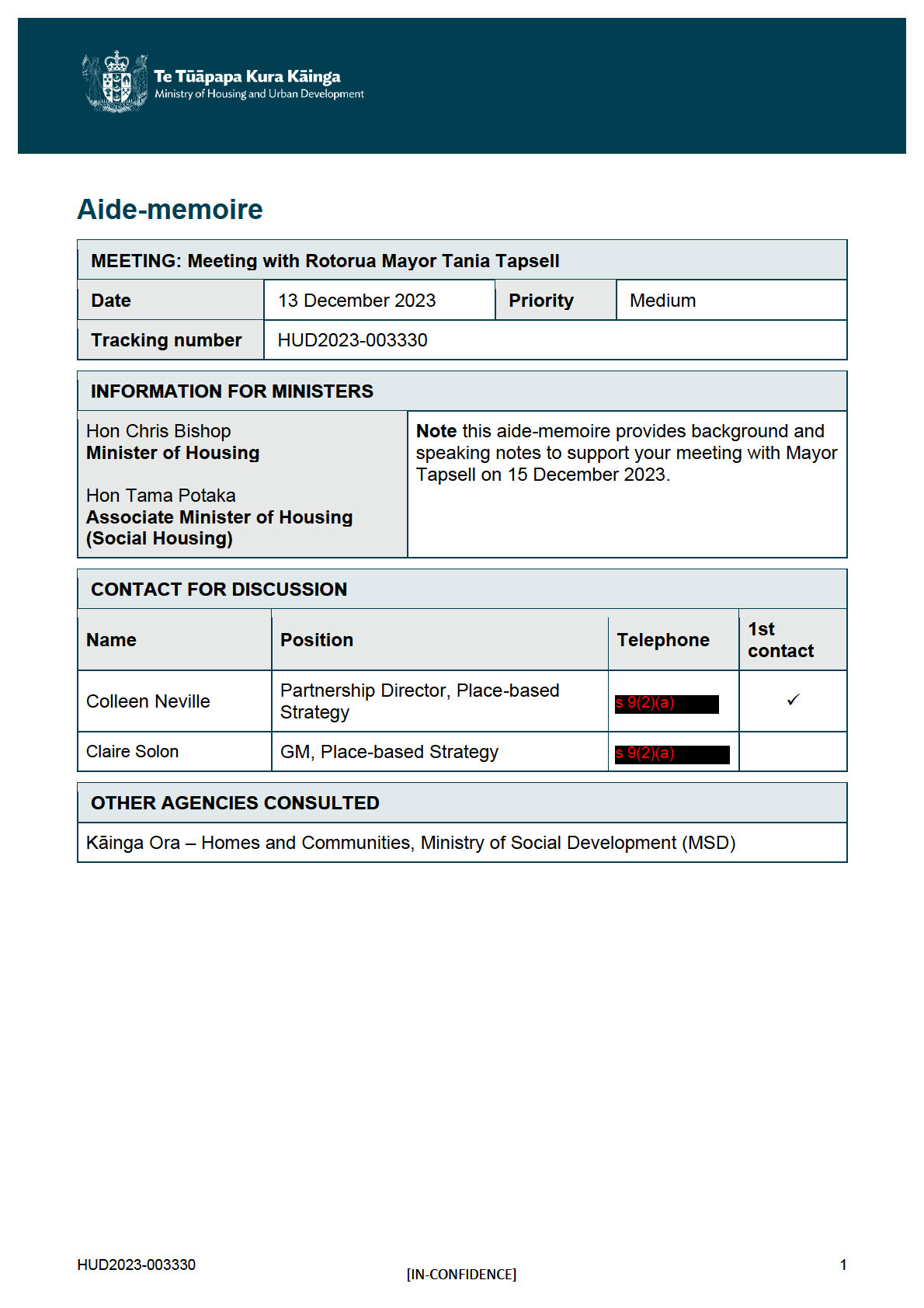
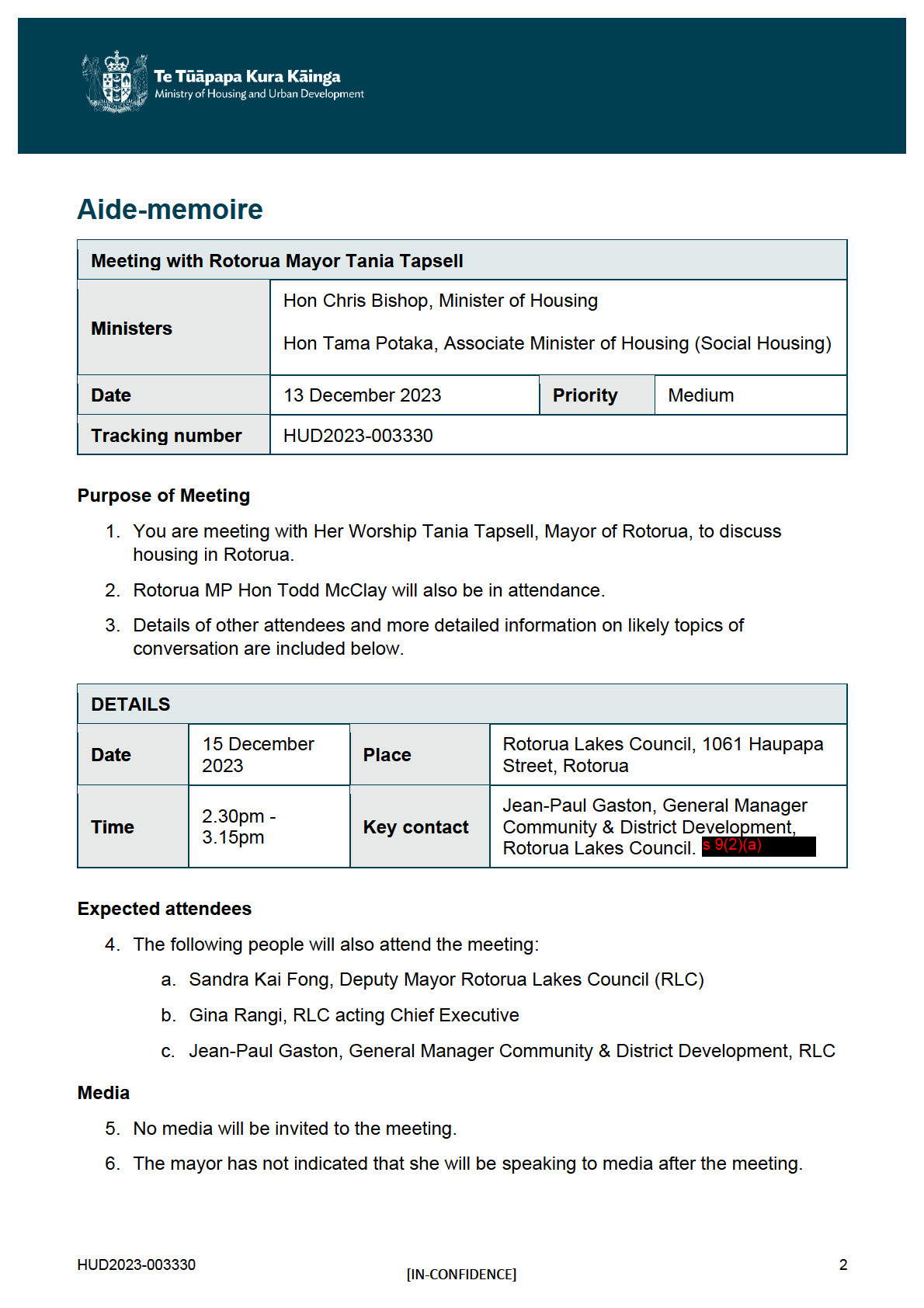

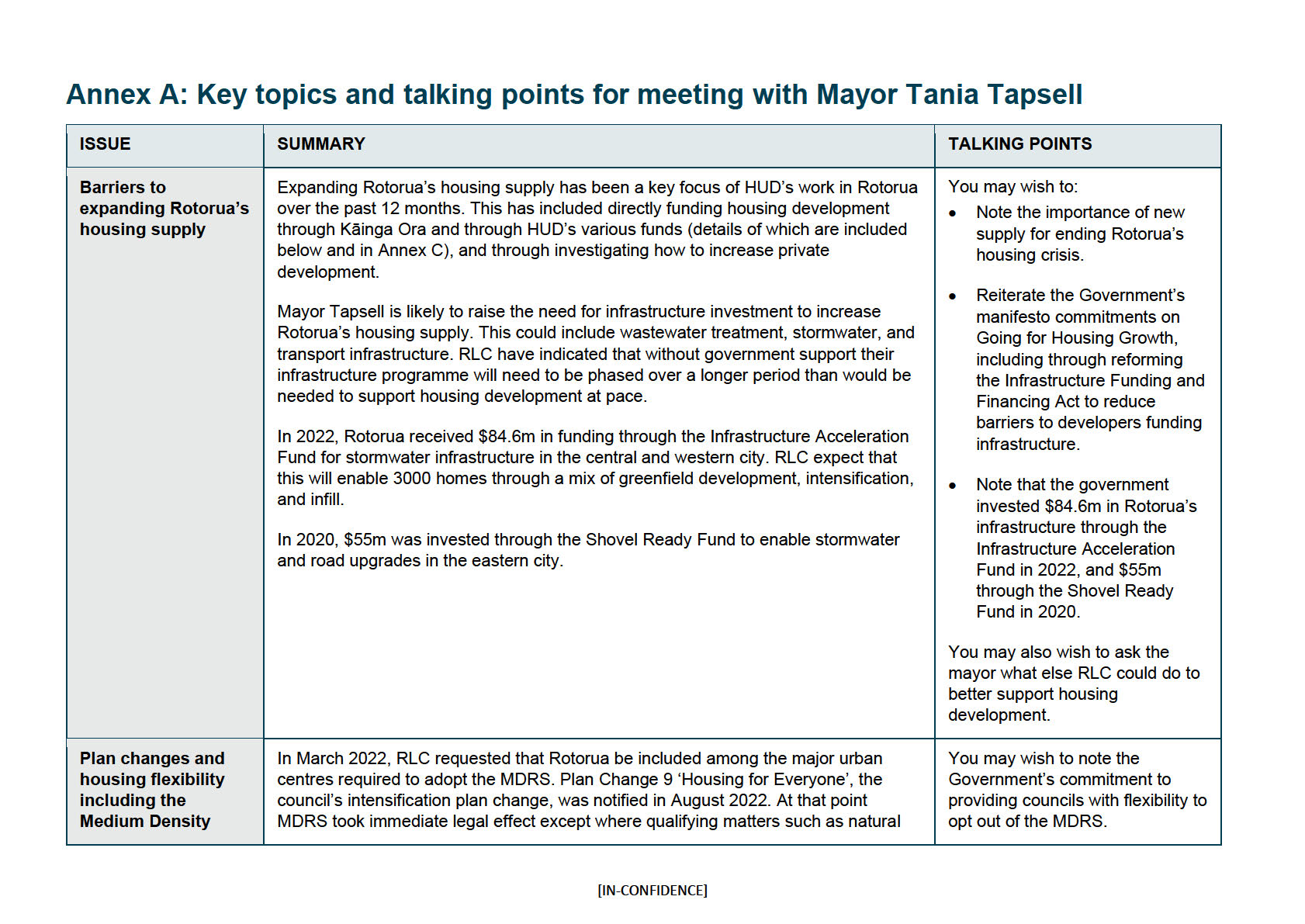
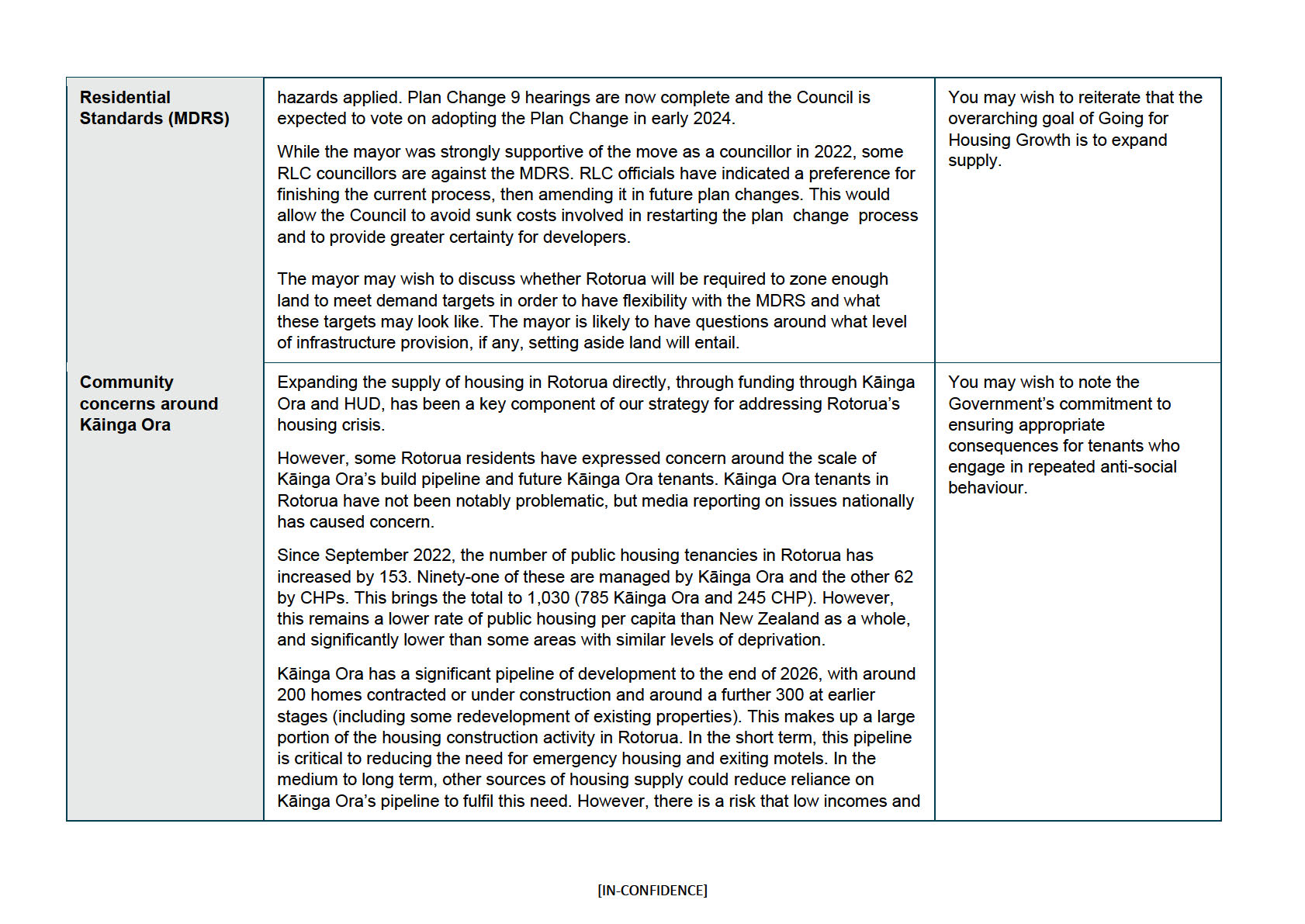


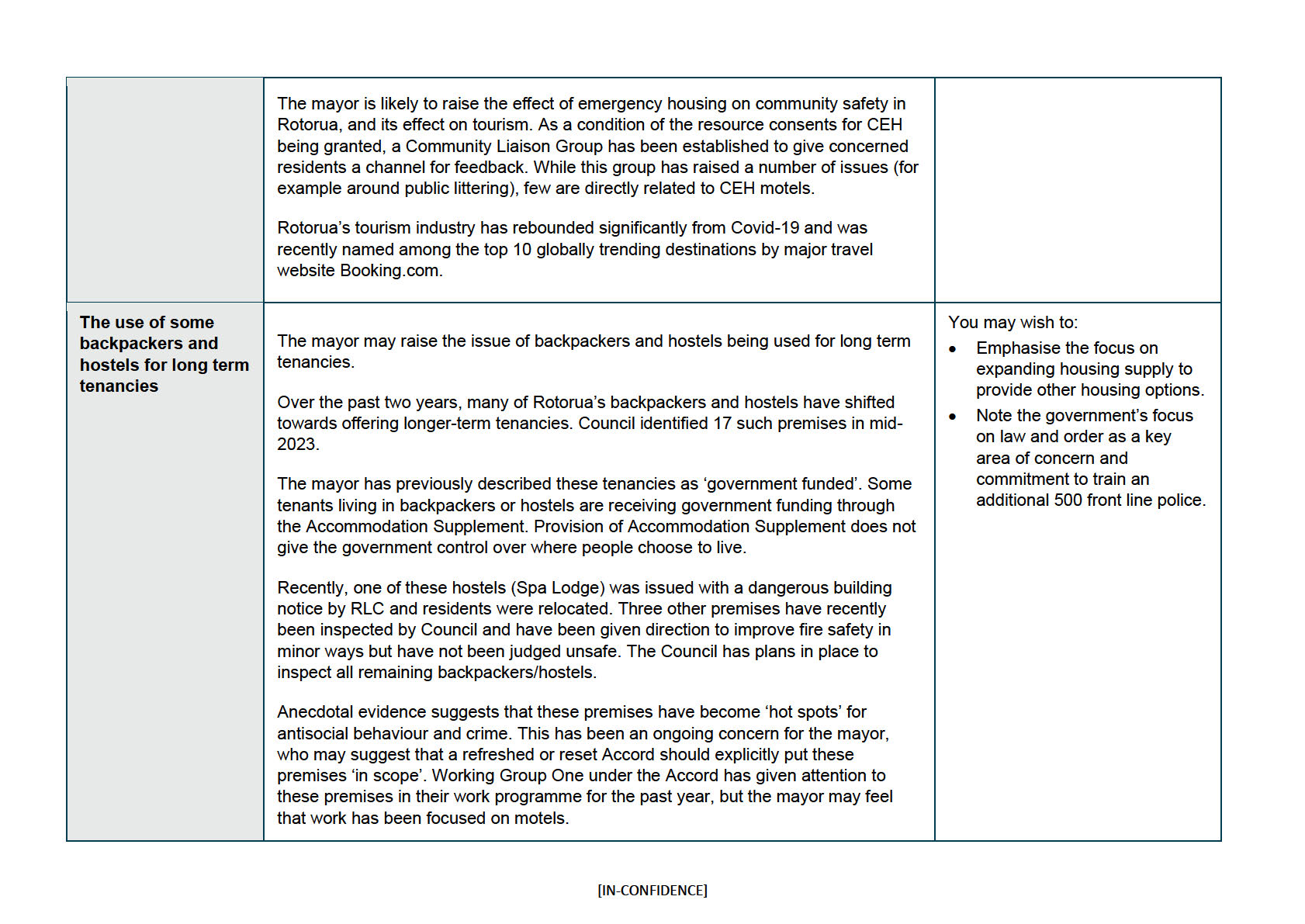
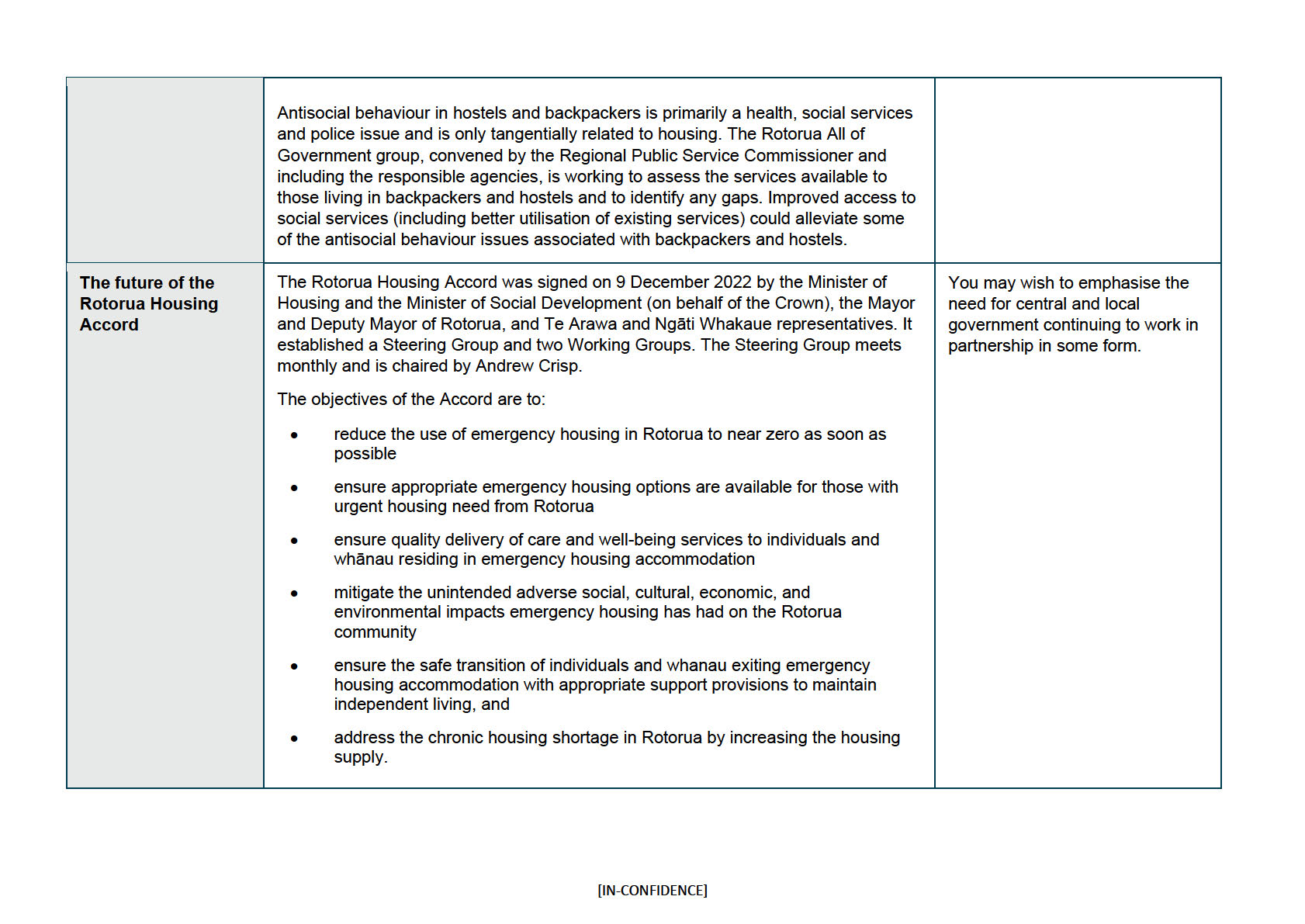
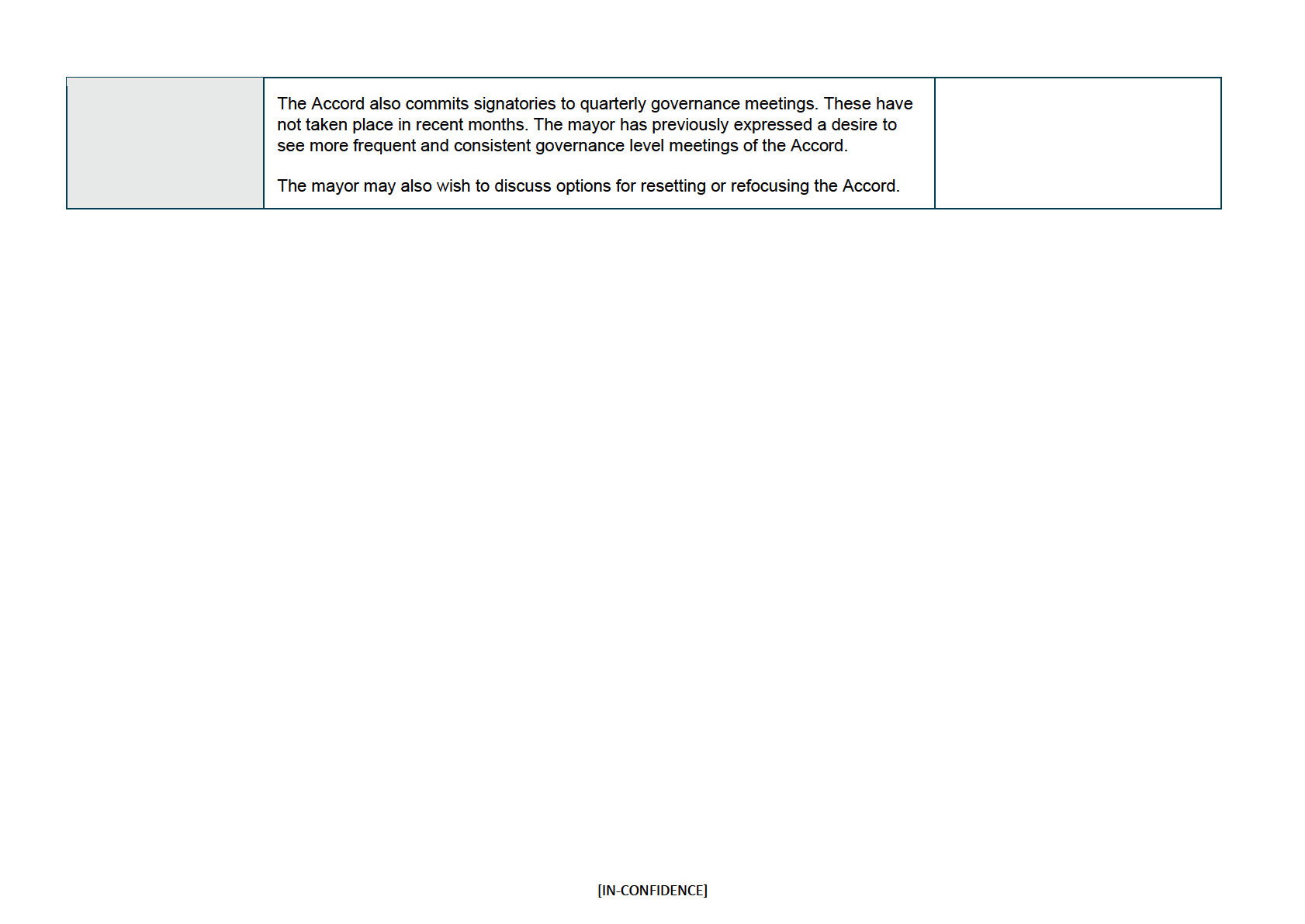
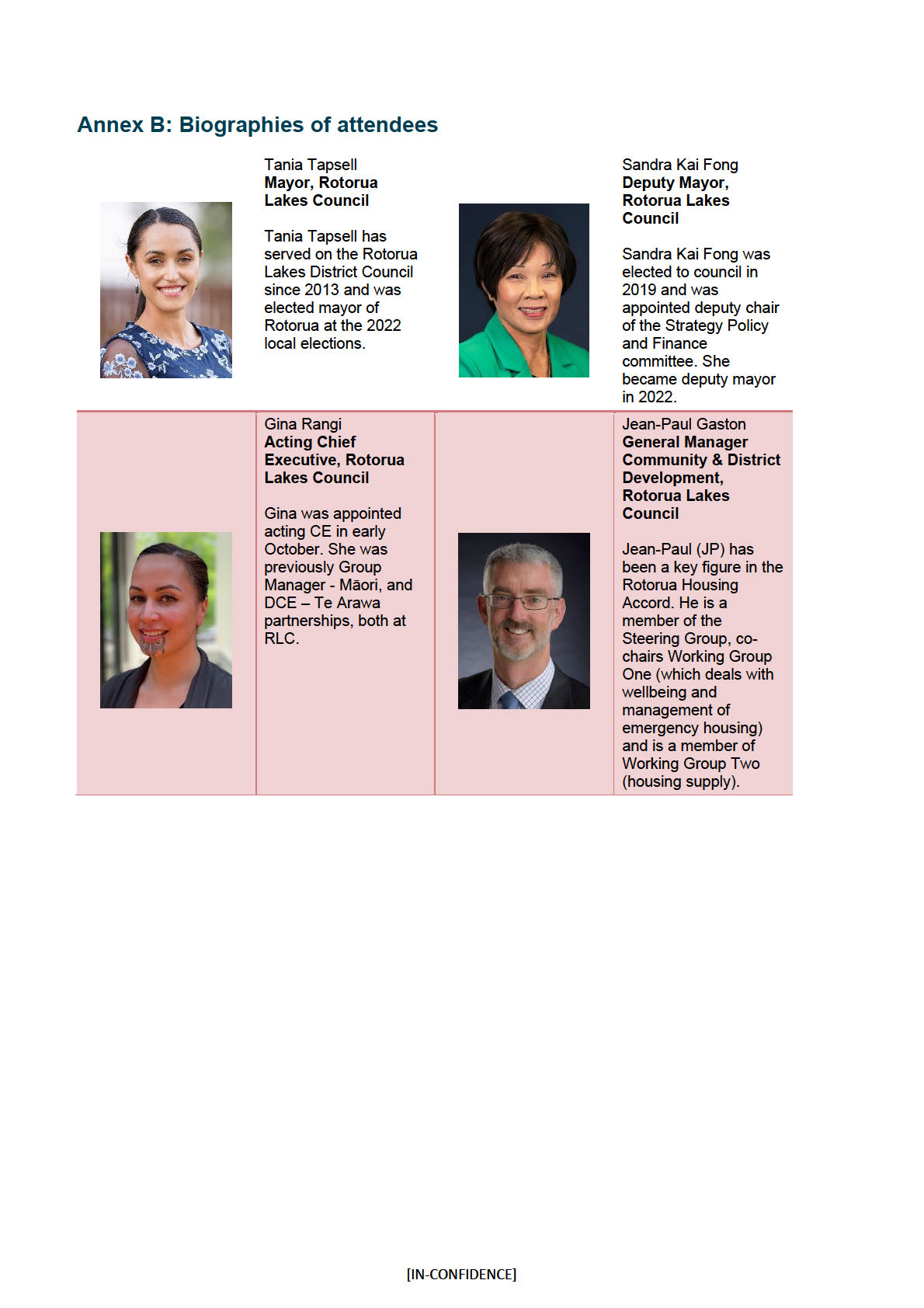

 Technical Notes
Technical Notes
* Due to delay in the data process, Housing First data has been carried over from last month.
Emergency Housing Special Needs Grants (EH SNGs)
Programme Provider Reporting
These are available to people who cannot remain in their usual residence, if any, and will not have access to other
Some of the data used in this report are based on Programme Provider reporting, which can be incomplete and may
accommodation that is adequate for their or their family’s needs.
be revised in future. The quality and completeness of provider reporting can vary from month to month. When a
report is missing in a given month, the previous month's report has been carried over.
Contracted Emergency Housing (CEH)
Ethnicity Reporting
In June 2021, Cabinet agreed to fund a series of actions to improve the provision of emergency housing in Rotorua,
including contracting specific motels for the use of families with children, providing wraparound support and
Transitional Housing and Contracted Emergency Housing programmes do not collect information on ethnicity.
establishment of a housing hub with local Iwi.
COVID 19 Response Motels programme collects only the primary ethnicity of an individual as reported.
COVID-19 Response Motels (COVID-19)
MSD reports total response ethnicity for Emergency Housing SNG primary clients. This means if a person identifies
with more than one ethnic group, they are counted in each applicable group, and the sum of responses for all ethnic
In April 2021, funding for additional housing places was secured to provide suitable accommodation for rough sleepers,
groups may exceed 100%.
reduce occupancy in high density accommodations such as night shelters and hostels, and meet other immediate
housing needs to reduce the impact of COVID 19.
Note: MELAA refers to Middle Eastern, Latin American, and African.
Transitional Housing (TH)
Transitional Housing is temporary accommodation and support for individuals or families who are in urgent need of
Households
housing. It provides warm, dry, short term housing for people and families who urgently need a place to stay. Some of
Household counts are as at the end of the month. There may be some movement in the numbers month to month
the Transitional Housing places are units in Motels.
due to occupancy levels at different times of the month.
Emergency Housing Special Needs Grants and Contracted Emergency Housing programme collect data at the
EH SNG Start/End of Spell Location Chart
household level, and demographic information is of the primary client.
This chart represents a number of clients starting and ending emergency housing spells in Rotorua. It is not an
Transitional Housing and COVID 19 Response Motels programme collects data at the individual level for all
of icial measure and is to be used only as an indicator for monitoring flow.
occupants. If more than one occupant shares the same unit and the same starting date, they are considered a
household.
The Emergency Housing Special Needs Grant is hardship assistance and paid in advance; because of this, MSD is
unable to identify when a client exits emergency housing.
Housing First programme collects data for the primary applicant of the household.
We are able to make an assumption of a client no longer being in an emergency housing accommodation
when they do not apply for an additional grant within 4 weeks of their previous one. This means that this
measure will always be one month behind.
A spell in emergency housing typically ends when a client has not been in emergency housing for four
Random Rounding
weeks or more. The graph in section 4 indicates the number of spells that started and ended in the past 12 months
Random rounding to base 3 is applied to all publicly released figures, ensuring there is little or no chance a figure
specific to the motel clients is staying.
could be identifying individuals. Zeroes, in this case, are not rounded to 3. Random rounding is applied to totals
and components separately, which can lead to rounded totals not equaling the sum of their rounded components.
The chart also identifies where a spell started outside Rotorua and continues outside of Rotorua.
This report was developed by Te Tūāpapa Kura Kāinga and MSD. This report aims to track progress on agreed
actions in Rotorua. Please contact Te Tūāpapa Kura Kāinga ([email address]) if you have any
enquiries.
2 of 2
[UNCLASSIFIED]

Document Outline

























